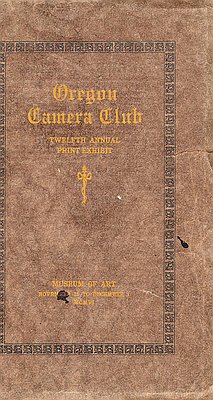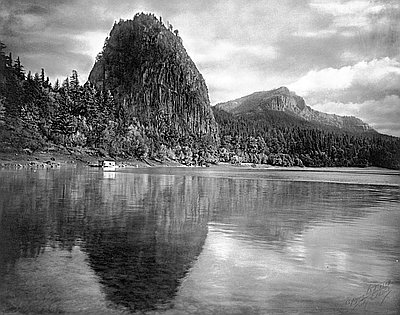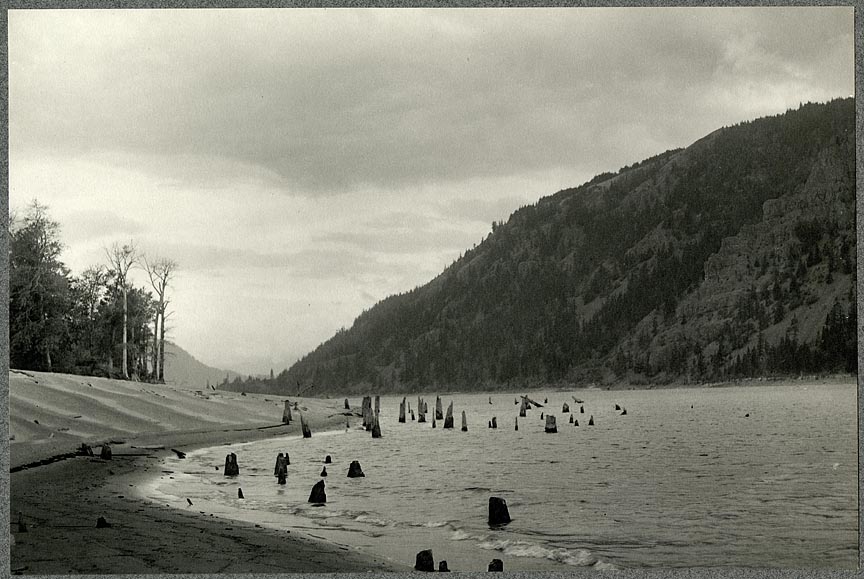- Catalog No. —
- bc006476; OrHi 89660
- Date —
- circa 1902-1904
- Era —
- 1881-1920 (Industrialization and Progressive Reform)
- Themes —
- Arts, Women
- Credits —
- Sarah Hall Ladd and Lily White photographs [graphic], Org. Lot 662, Oregon Historical Society Research Library
- Regions —
- Columbia River Portland Metropolitan
- Author —
- Sarah Hall Ladd (1857-1927), photographer
The Submerged Forest, by Sarah Hall Ladd
Sarah Hall Ladd took this photograph of the “submerged forest” on the Columbia River circa 1902-1904. The remains of trees in the river are found 25 miles above Cascade Rapids. Most of this area is now submerged behind Bonneville Dam.
Lewis and Clark were the first Euroamericans to record this phenomenon. They made note in their journals on their way down the Columbia in October 1805 and again on their return trip. In an April 14, 1806, entry, Lewis observed “the trunks of many large pine trees s[t]anding erect as they grew at present in 30 feet water; they are much doated and none of them vegetating.”
Subsequent travelers, explorers, and scientists, including the Wilkes Expedition in 1841, also tried to make sense of the odd formation. Modern scientists theorize that the trees may have been submerged as the result of a strong regional earthquake in about 1700, possibly the same earthquake that caused a tsunami that ravaged the Northwest coast that same year.
The earthquake caused a landslide that created a large earthen dam in the river. This dam stopped the river’s flow and submerged the still-living trees under water and tons of accumulated silt. Eventually, the dam broke, the waters receded, and the silt gradually eroded, exposing the dead, yet preserved, tree stumps and trunks.
Sarah Hall Ladd, a pioneering amateur photographer, was important to the early photographic movement in Portland in the first decades of the twentieth century. Ladd (formerly Hall) was born in Somerville, Mass., in 1857, and came to Portland with her new husband Charles Ladd in 1881. Charles was the son of leading Portland businessman William S. Ladd.
Sarah Hall Ladd joined the Oregon Camera Club in September 1899, and, by early 1901, a number of her works were on exhibition in San Francisco. In 1903, leading New York photographer Alfred Stieglitz formed Photo-Secession, a group of elite American photographers that never numbered more than 105 members, and both Sarah Hall Ladd and Lily White were included among the select membership.
In 1903, Ladd and White began taking extended trips on the Columbia River on White’s custom-built houseboat, the Raysark, a vessel that contained a darkroom.
Ladd had become a successful and highly regarded photographer by the early twentieth century while also continuing to participate actively in Portland social life. After about 1904, Ladd’s other responsibilities took time away from her photography. Ladd assisted her husband Charles when he became involved in the preparations for Portland’s 1905 Lewis and Clark Exposition. In 1910, the Ladds moved to the town of Carlton, Oregon, after Charles became president of the Carlton Consolidated Lumber Company. In spite of these additional obligations, Ladd exhibited fourteen photographs at the 1915 Panama-Pacific International Exposition in San Francisco.
Ladd became prominent in the Christian Science movement beginning in 1911. After Ladd’s husband died in 1920, she moved to Carmel, California in late 1924 to join her long-time friend, Lily White. Ladd died in Carmel on March 30, 1927.
Further reading:
Carole Glauber, “Eyes of the Earth: Lily White, Sarah Ladd, and the Oregon Camera Club,” Oregon Historical Quarterly 108:1 (Spring 2007), 34-69.
Richard L. Hill, “Science-Landslide Sleuths,” Oregonian May 15, 2002.
Jim E. O’Connor, “The Evolving Landscape of the Columbia River Gorge: Lewis and Clark and Cataclysms on the Columbia,” Oregon Historical Quarterly 105:3 (Fall 2004), 390-421.
Written by James V. Hillegas, Oregon Historical Society, 2008.
Related Historical Records
-
The Oregon Camera Club
The Oregon Camera Club, organized in 1895 (versions of which exist today), was a popular amateur photography society that met monthly in Portland. Its formation mirrored the growth …

-
Castle Rock and Houseboat by Lily White
Lily White took this photograph of her houseboat Raysark at the base of “Castle Rock” on the Washington State side of the Columbia River in about 1902. The …

